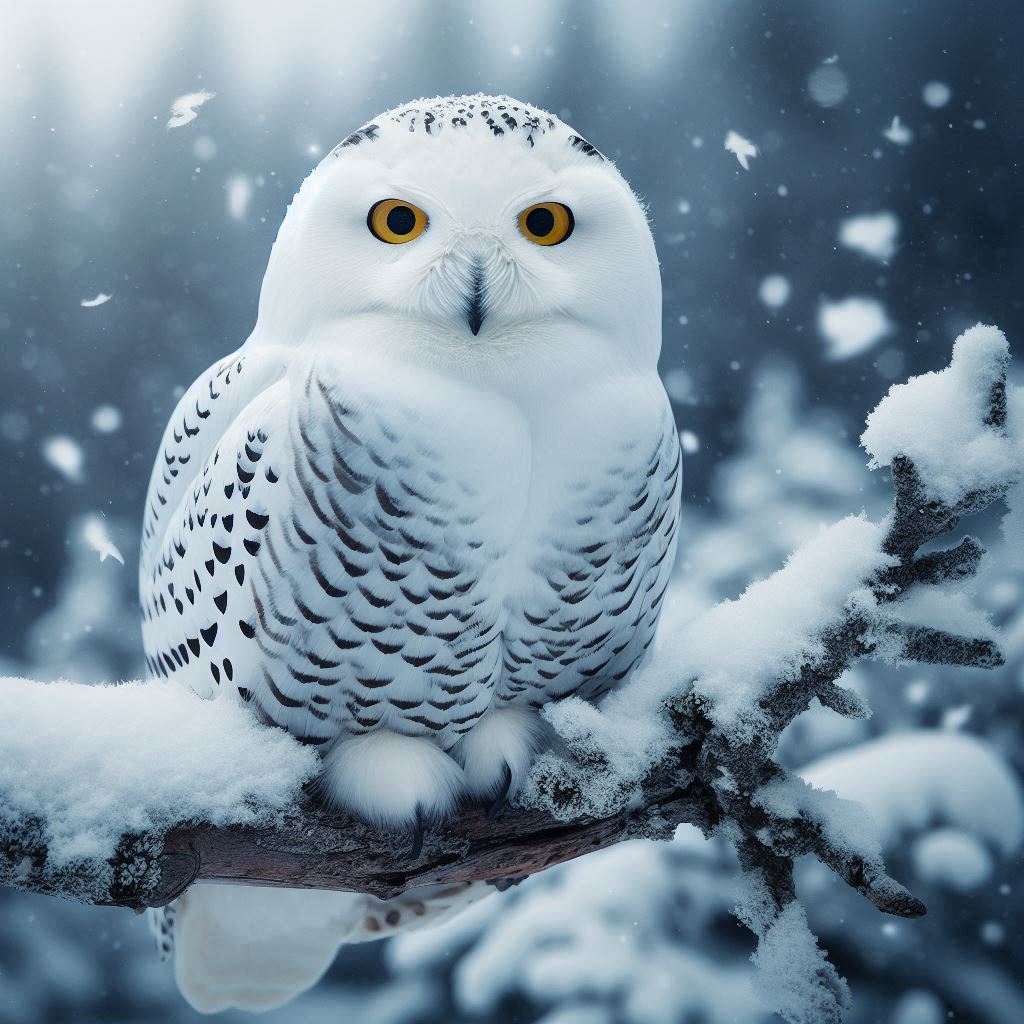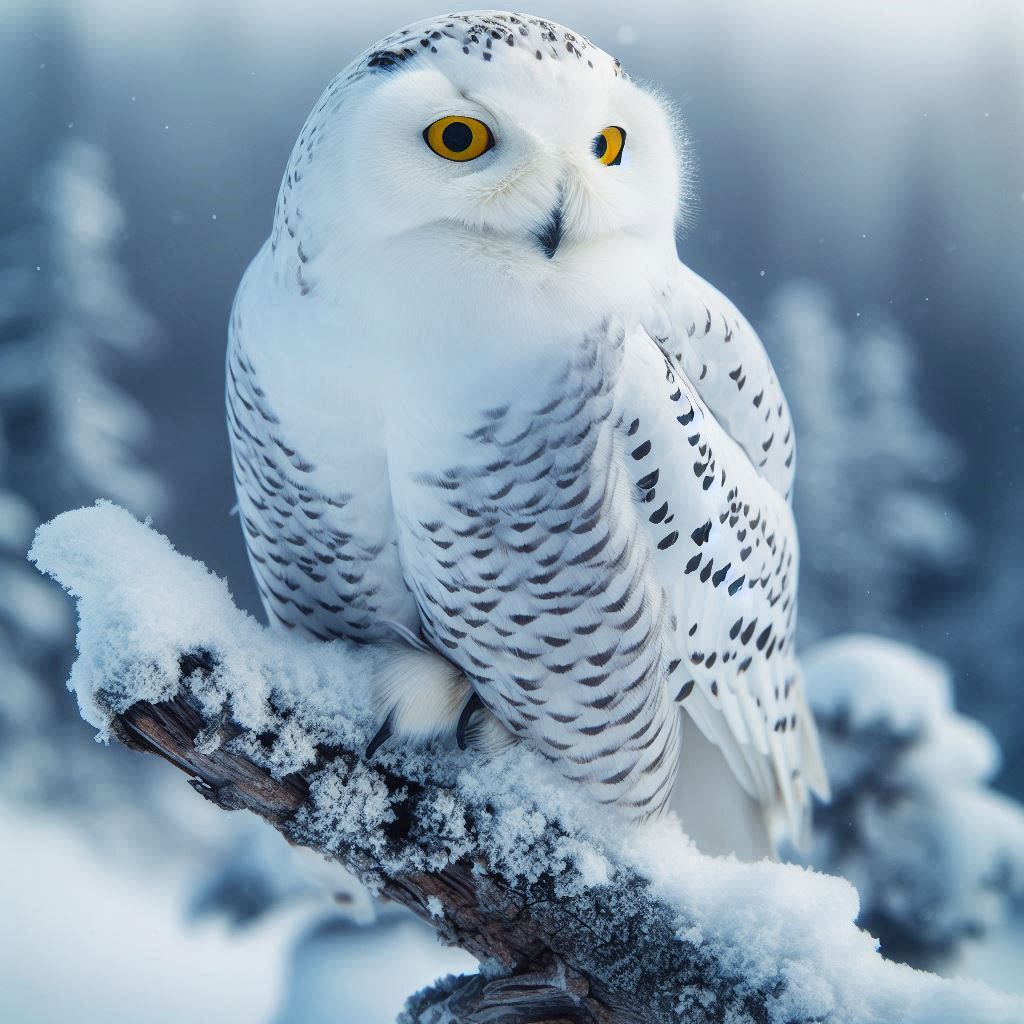Arctic Snowy Owl: Majesty of the Frozen Wilderness
Arctic Snowy Owl
In the heart of the Arctic tundra, where vast expanses of white stretch endlessly beneath a pale sky, resides one of nature’s most captivating creatures—the Arctic Snowy Owl. With its striking appearance and ethereal presence, this majestic bird has captured the imaginations of many. Its haunting hoots echo through the frozen wilderness as it glides silently over snow-covered landscapes in search of prey. As winter descends upon these icy realms, the snowy owl becomes a symbol not just of survival but also of beauty amid harsh conditions.
Join us on an exploration into the world of this incredible avian predator. From its unique adaptations to thrive in frigid climates to its role in various cultures and ecosystems, we’ll unveil all that makes the Arctic Snowy Owl a true marvel. Whether you’re an aspiring ornithologist or simply someone who admires wildlife from afar, prepare to be enchanted by stories and facts about this stunning bird that reigns supreme over its frosty domain.
Physical Characteristics and Adaptations
The Arctic Snowy Owl is a striking bird, easily recognized by its stunning white plumage. This snowy coat provides excellent camouflage against the icy backdrop of its tundra habitat. The few dark markings on their feathers not only enhance their beauty but also help in individual identification.
Physically, these owls are robust with a large wingspan that can reach up to five feet. Their powerful talons and beak are perfectly adapted for hunting in harsh conditions.
To endure extreme cold, they possess thick layers of down feathers close to their skin. This insulation retains heat during frigid nights under the northern lights.
Their keen eyesight allows them to spot prey from great distances, making them proficient hunters at dawn and dusk when many animals are active.
Snowy Owls also have distinctive yellow eyes that add an air of mystery as well as provide excellent vision even in low light situations.
Habitat and Range
The Arctic Snowy Owl thrives in some of the most extreme environments on Earth. This magnificent bird calls the open tundra its home, where vast stretches of white snow and sparse vegetation create a stunning backdrop for its striking appearance.
Found primarily in the Arctic regions of Canada, Alaska, and parts of Greenland, these owls are also known to migrate south during winter months. They can occasionally be spotted as far down as the northern United States.
Their preference for flat landscapes allows them to hunt effectively. The wide-open spaces enhance their ability to spot prey from great distances while remaining concealed against the stark terrain.
Snowy Owls are adept at adapting to varying conditions within their range. Whether perched silently on a snowy mound or soaring through frigid skies, they embody resilience amidst relentless winters.
The Life Cycle of an Arctic Snowy Owl
The life cycle of the Arctic Snowy Owl is a fascinating journey marked by resilience and adaptation. Breeding typically occurs during the short summer months, when food availability peaks in the tundra.
Nest sites are often chosen on elevated ground, providing a strategic lookout for potential predators. A clutch can range from three to eleven eggs, with both parents taking turns incubating them.
Once hatched, fluffy gray chicks emerge, relying heavily on their parents for sustenance. These young owls grow quickly and begin to explore their surroundings within weeks.
By late summer, they fledge and start honing their hunting skills. However, survival remains challenging as they learn to navigate the vast Arctic landscape.
As winter approaches, many juveniles disperse over long distances in search of food and territory. This nomadic phase plays a crucial role in establishing new breeding pairs for future generations.
Hunting and Diet
The Arctic Snowy Owl is an exceptional hunter, perfectly adapted to its frigid environment. These magnificent birds primarily prey on small mammals, particularly lemmings and voles. Their keen eyesight allows them to spot movement across vast snowy landscapes.
Employing a silent flight technique, they swoop down with precision and grace. The snow-covered terrain provides excellent camouflage for their pale feathers, making it easier to stalk unsuspecting prey.
During the summer months, when food sources are plentiful, these owls can consume up to five lemmings in one sitting. They often cache surplus food for later use, ensuring survival during harder times.
Interestingly, their diet can vary based on availability; they may also hunt birds or even larger mammals when necessary. This adaptability plays a significant role in their resilience against the harsh Arctic conditions.
Threats to the Species
The Arctic Snowy Owl faces a variety of threats that jeopardize its survival. Climate change is perhaps the most significant challenge. Warming temperatures disrupt their breeding grounds and reduce snow cover, which they depend on for hunting.
Habitat destruction also poses a danger. As humans expand into these remote areas, industrial activities can fragment their environment, making it difficult for them to thrive in traditional nesting sites.
Pollution plays a critical role as well. Toxins accumulate in the food chain, affecting not only rodents but also the owls that prey on them. This bioaccumulation leads to health issues and reproductive failures.
Human interference cannot be overlooked either. Disturbance from researchers or wildlife enthusiasts during key breeding seasons can stress these majestic birds, impacting their ability to rear young successfully. These combined pressures threaten the delicate balance of life for the Arctic Snowy Owl.
Conservation Efforts and Success Stories
Conservation efforts for the Arctic Snowy Owl have gained momentum in recent years. Organizations and researchers are working tirelessly to monitor populations, ensuring these majestic birds thrive in their natural habitats.
Community involvement plays a crucial role in these initiatives. Local volunteers often participate in citizen science projects, helping track migration patterns and nesting sites.
Success stories emerge from dedicated conservation programs that focus on habitat preservation. By protecting tundra ecosystems, we not only safeguard the snowy owl but also countless other species reliant on this fragile environment.
Education is another vital aspect of conservation. Schools and environmental groups promote awareness about the importance of preserving snowy owls’ habitats, inspiring future generations to appreciate wildlife.
Through collaboration among scientists, communities, and policymakers, significant strides have been made toward ensuring the survival of this iconic bird amidst changing climates and habitat challenges.
The Role of the Arctic Snowy Owl in Indigenous Cultures
The Arctic Snowy Owl holds a significant place in the lore of many Indigenous cultures across the northern tundras. Revered as a symbol of wisdom, these majestic birds are often associated with spiritual guidance and protection.
In various traditions, the owl’s silent flight and striking appearance have led to its portrayal as a guardian spirit. Its presence is believed to signify change or transformation, guiding hunters during dark winter nights.
For some tribes, stories passed down through generations celebrate the snowy owl’s role in maintaining balance within nature. It teaches respect for wildlife and emphasizes harmony with one’s environment.
Artisans frequently depict this beautiful bird in their crafts, illustrating its importance not only as an emblem but also as an integral part of cultural identity. The Arctic Snowy Owl continues to inspire reverence among those who live close to its frosty habitat.
How to Observe and Photograph These Magnificent Birds
Observing the Arctic Snowy Owl is a thrilling experience. Patience and preparation are key. Start by finding their preferred habitats, usually open tundras or coastal areas.
Dress in layers to stay warm while you wait for these majestic creatures to appear. Early mornings or late afternoons offer the best light for photography and higher chances of spotting them.
Bring binoculars to spot distant owls resting on low perches. Remember to maintain a respectful distance; these birds require peace as they hunt and rest.
When photographing, focus on capturing their striking features—the vivid yellow eyes and intricate feather patterns. A long lens helps capture stunning detail without disturbing them.
Consider using natural settings as your backdrop, highlighting the owl’s beauty against the snowy landscape.
Always prioritize ethical practices: never approach too closely, ensuring you leave minimal impact on their habitat.
How the Arctic Snowy Owl Survives the Harsh Tundra
The Arctic Snowy Owl is a master of survival in one of the planet’s most challenging environments. Its thick, insulating feathers provide essential warmth against frigid temperatures that can plummet well below freezing.
These magnificent birds are equipped with specialized adaptations, such as dense plumage and feathered feet. The latter acts like natural snowshoes, allowing them to navigate the icy terrain effortlessly.
Their keen eyesight plays a critical role in hunting. They can spot prey even under layers of snow or during long Arctic nights. This exceptional vision helps them locate lemmings and other small mammals from miles away.
Moreover, their white camouflage blends seamlessly into the snowy landscape, offering an advantage over both predators and prey alike. In this frozen wilderness, every adaptation counts for survival. Each day poses new challenges but also opportunities for these resilient hunters to thrive amidst harsh conditions.
The Arctic Snowy Owl: A Symbol of Arctic Beauty
The Arctic Snowy Owl embodies the enchanting beauty of the frozen north. Its striking white plumage blends seamlessly with the snowy landscape, evoking a sense of tranquility and elegance.
These magnificent birds are not just visually stunning; they symbolize resilience in one of Earth’s harshest environments. Their presence serves as a reminder of nature’s artistry and adaptability.
Culturally, they hold significance for many Indigenous communities, representing wisdom and strength. The snowy owl often appears in folklore, embodying deeper connections to the land.
Witnessing an Arctic Snowy Owl gliding gracefully through its icy domain is an unforgettable experience. Each sighting feels like a glimpse into a world untouched by time.
This majestic creature continues to inspire awe and admiration across cultures, solidifying its status as an icon of Arctic beauty.
Arctic Snowy Owl: Nature White Phantom
The Arctic Snowy Owl glides through the winter landscape like a ghost in the night. Its stunning white plumage blends seamlessly with snow-covered terrain, making it appear almost ethereal.
This majestic bird is not just a visual marvel; it’s also an exceptional hunter. With keen eyesight and silent flight, it stalks its prey under the cover of darkness. The stark contrast between its bright feathers and the dark eyes creates an enigmatic presence that captivates onlookers.
As dusk falls, these owls come alive. Their haunting calls echo across vast tundras, adding to their otherworldly aura. Observing them can feel like witnessing a mythical creature from folklore manifest into reality.
In every flap of their wings lies grace and power—a true testament to nature’s artistry in survival within one of Earth’s most challenging environments.
Journey Through the Arctic: Tracking the Snowy Owl
Tracking the Arctic Snowy Owl is an adventure like no other. The frozen landscapes are vast and mesmerizing, offering a stunning backdrop for this majestic bird.
With each step through the crisp snow, you become acutely aware of your surroundings. The silence is palpable, only occasionally broken by the soft flapping of wings overhead. Spotting these elusive creatures requires patience and keen observation skills.
Look for their distinctive white feathers against the icy terrain. Their camouflage blends seamlessly into the environment, making them hard to detect at times.
Using binoculars or a camera with a zoom lens enhances your experience. You can capture their striking features without disturbing their natural habitat.
Engaging with local wildlife experts adds depth to the journey. They share insights on owl behavior and help locate nesting sites along remote tundra trails. This connection enriches every moment spent tracking these incredible birds in their snowy realm.

Incredible Facts About the Arctic Snowy Owl You Didnt Know
The Arctic Snowy Owl is a truly remarkable bird with a number of fascinating traits that set it apart. For starters, did you know that their eyes are not just striking but also uniquely adapted to the extreme conditions of the Arctic? Their yellow eyes can detect prey at great distances, even in low light during polar nights.
Another incredible fact is their ability to camouflage perfectly against the snow-covered landscape. The snowy owl’s white plumage helps it blend seamlessly into its frigid environment, making it an efficient hunter and protector from potential threats.
These owls can weigh up to 6.5 pounds and have wingspans reaching over five feet! This impressive size allows them to soar gracefully across vast tundra landscapes while hunting for lemmings and other small mammals.
Interestingly, unlike most owls who are nocturnal, the Arctic Snowy Owl often hunts during daylight hours. This behavior allows them to take advantage of the long summer days when food is plentiful.
Moreover, these majestic birds have been known to migrate southward in search of better hunting grounds during harsh winters or when food becomes scarce. Their migratory patterns can stretch hundreds of miles away from their breeding territories in search of sustenance.
Snowy Owls are also social creatures compared to many other owl species; they can be seen roosting together outside of breeding season or gathering around abundant food sources. They communicate through a variety of vocalizations including hoots and hisses which convey different messages about territory and mating.
Every winter brings new opportunities as snowy owls become more visible across various regions where they might not typically reside year-round due to migration patterns influenced by climatic changes or local rodent populations.
With all these unique attributes combined with their beauty and gracefulness soaring through icy skies—the Arctic Snowy Owl continues capturing our imagination while reminding us how splendid nature’s diversity truly is.

